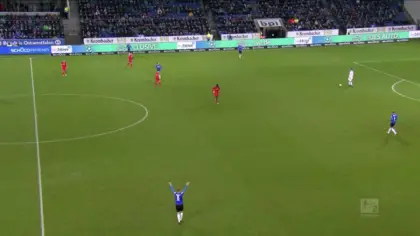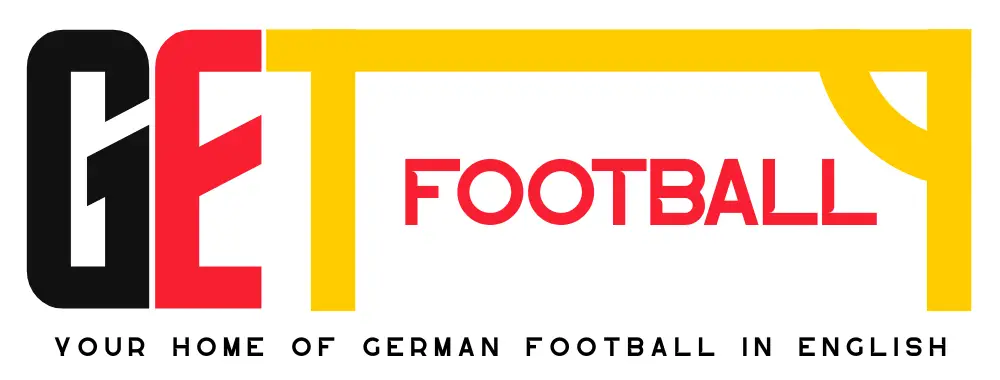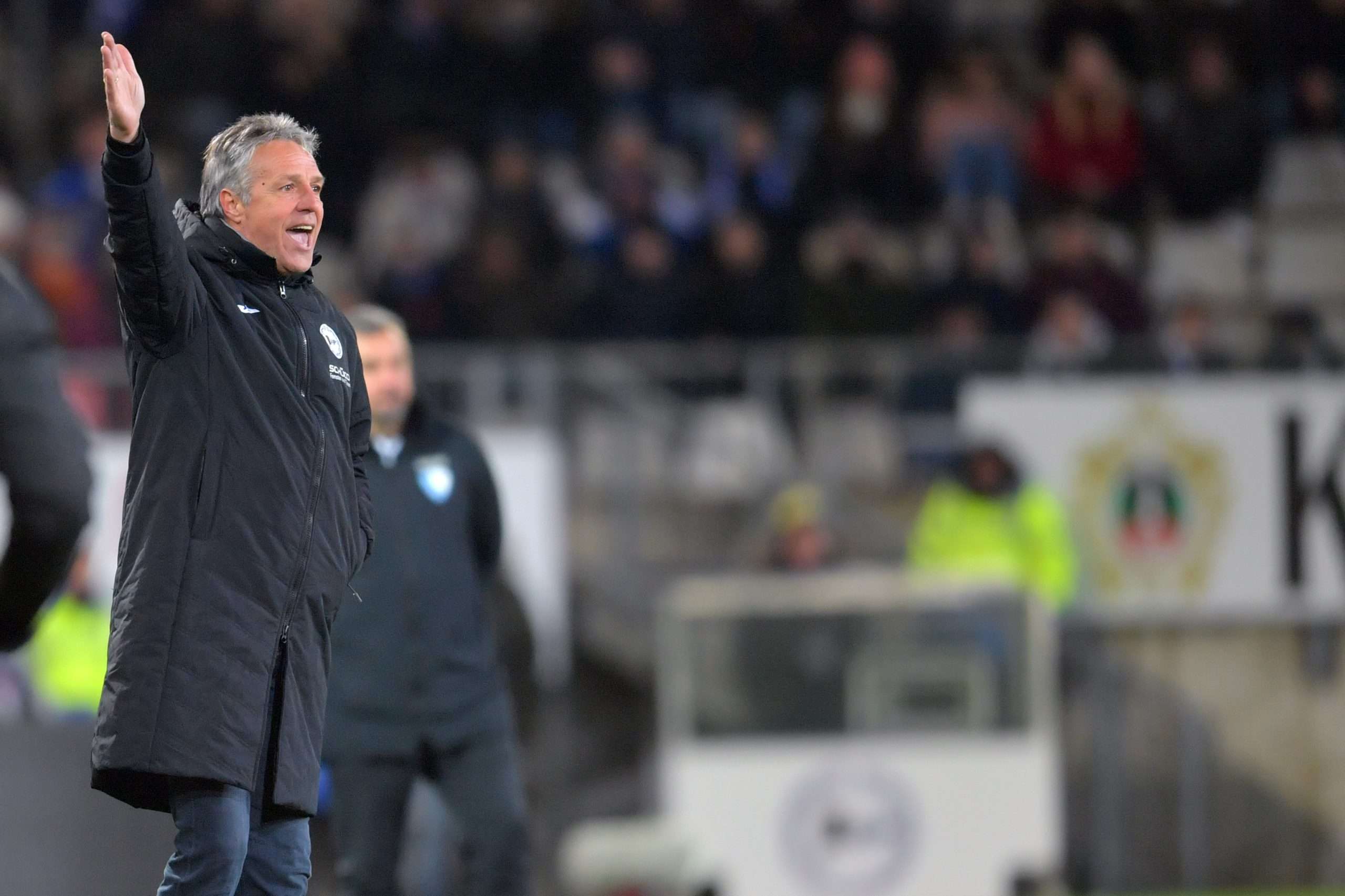Arminia Bielefeld maintained their spot at the top of the 2. Bundesliga table after their 2-0 win over Bochum and draw against Erzgebirge Aue. Arminia, who were last in the Bundesliga during the 2008-09 season, have found themselves leading the race for promotion against favourites and recent Bundesliga clubs, Hamburg and Stuttgart.
Unlike Stuttgart and Hamburg, Arminia, led by manager Uwe Neuhaus, have taken a pragmatic approach to the 2. Bundesliga that has proven successful so far. Arminia’s tactical flexibility and the simplification of their build-up play and transitions, in addition to goals flying in from veteran striker Fabian Klos and winger Andreas Voglsammer, have been key factors in their success for the first half of the season. Arminia are demonstrating there is a different approach to establishing a serious 2. Bundesliga promotion campaign and they could very well be an entertaining team in the Bundesliga, should they earn promotion.
Tactical Flexibility and Pragmatism
In a league that is dominated by clubs led by managers with strict tactical identities, like Dieter Hecking’s slow tempo passing at Hamburg or Stuttgart’s well-orchestrated build-up play from now-former manager Tim Walter, Arminia Bielefeld’s tactically pragmatic approach is refreshing and stands out. Uwe Neuhaus’s Arminia brings forth another blueprint on how to establish a legitimate 2. Bundesliga promotion campaign. Their pragmatism and tactical flexibility can be seen both in terms of their general formation and their style of play.
First, Neuhaus has deployed a range of formations throughout the season. Although Arminia’s backline has remained a standard four-chain, their midfield structure in the attacking phase has altered their general formation. Neuhaus has played a 4-4-2, 4-4-1-1, 4-2-3-1, and 4-3-3. Each formation has slightly different advantages and disadvantages for Arminia, it is not clearly a reactive formation change but one in which Neuhaus hopes to gain a net positive in terms of pros and cons to their formation in relation to their opposition.
Further than the flexible formations deployed by Arminia, the tactical flexibility in their style of play allows them to overcome different questions posed by their opponents. Besides a few reoccurring principles of play in Arminia’s build-up within their own half, Arminia’s pressing, tempo of passing, the area of the pitch they create chances, and how they score goals are all diverse, reflecting a versatile cohesive team. For example, when Arminia traveled to Bochum in the first half of the season, Arminia defended in a low block extremely well and launched efficient counterattacks through the wide areas. However, against Stuttgart they displayed a well-organised high press in order to disrupt Stuttgart’s build-up play.
Statistically Arminia is seen as a tactically flexible team as well when compared to other 2. Bundesliga sides. They have scored 37 goals, 19 of which were from open play, 8 set-pieces, 4 counterattacks, 5 penalties, and 1 own goal. 19 open play goals put them around league average, while 8 goals from set-pieces has them tied for second in the league, a somewhat surprise for the league leaders. Arminia can benefit and create goals in variety of ways, and rarely does a 2. Bundesliga league leader take advantage of set-pieces as well as Arminia have. The most interesting aspect of Arminia’ style of play is the type of passes they’ve attempted.
Below is the table of the number of long balls and short passes per game of the top three clubs in the 2. Bundesliga.
|
Team |
Long Balls per Game |
Short Passes per Game |
|
Arminia Bielefeld |
71 |
455 |
|
Stuttgart |
59 |
540 |
|
Hamburg |
57 |
458 |
Arminia surpass both Stuttgart and Hamburg in long balls per game and are third most in the league for the metric. Impressively, they are able to do so while still remaining third most in the league in short passes per game, only just behind Hamburg, both of whom trail a possession heavy Stuttgart side. This reflects Arminia’s ability to play well organised long balls forward while at times focusing on dominating possession when needed. While they can either play long balls or short passes, either approach Arminia is able to maintain a high pass completion rate and control possession, a testament to Neuhaus and his team. They tie Hamburg for second in the league with 55% average possession over the season and third in the league, behind Hamburg and Stuttgart, with 82.8% pass accuracy.
Simplified Build-up and Transitions
Arminia’s strength largely lays in their tactical flexibility, but credit should be given to how well they simplify important basic principles of their play that are maintained regardless of their approach. Arminia are able to transition, both into their attacking phase and defensive organization, and have solid structure to their build-up play. The key for Neuhaus’ team in accomplishing these two areas of their game is to keep it simple.
First Arminia put an emphasis on building up play from within their own half. This is emphasised despite Arminia’s overall tactical plan for the game. In matches that Arminia sought to sit back and counter with long balls and in matches they aimed to dominate possession, Arminia deployed an efficient build-up structure from their goalkeeper. Below we can see an example of Arminia building from their goalkeeper.

Arminia simplified their playing principles during the build-up phrase, relying on the backline to create width, stretching the field. Above we can see Arminia’s goalkeeper Stefan Ortega is comfortable having the ball at his feet well outside of his box. His two centre-backs drop deep and wide, almost completely laterally of Ortega, forming almost a 3-man chain. This gives Arminia’s wingbacks freedom to, not only hug the touchline, but take a higher position. This allows Arminia to maximize the space available to them while stretching their opponent’s front press. Meanwhile the width provided by Arminia’s wingbacks allows Arminia options to switch the point of attack from either side, further stretching opponents shape, or allows an Arminia central midfielder to drop into the vacant pivot position to progress the build-up play through the middle.
Arminia’s simple yet effective build-up play isn’t the only aspect of their game they’ve made efficient and simple, Uwe Neuhaus’ side are also consistent in their counter pressing. Although Arminia might have differing levels of aggression in their pressing that can be either a high press or a low block, the moments after Arminia lose their ball, they are constantly counter pressing the opponent, even only for five seconds before getting into their defensive shape. Arminia’s counter press is usually ball-orientated, meaning Arminia’s 3 closest players to the ball when the ball is won by the opponent press the ball immediately. The goal for Arminia is to either win the ball back immediately or at least cause the opposition problems while the rest of their team gets into their defensive shape.
Arminia typically counter press with their striker, attacking midfielder and a winger, and once they begin their counter press, even for just a few seconds, Arminia’s wingbacks and central midfielders can be seen sprinting into their defensive shape, giving Arminia defensive stability while eliminating their opponents chance to counterattack. Arminia’s counter press is not an elaborate system that aims to take risks in pressing and win the ball back, instead acts as a simple way to allow their team to get into a defensive shape. It can be accomplished in any tactical system or formation that Uwe Neuhaus sets the team in either.
Klos and Vogelsammer
Arminia Bielefeld’s success this season would not happen without the contributions of their 32-year old striker Fabian Klos and 28-year old winger Andreas Voglsammer. Both have combined for 21 goals, more than half of the team’s total, and 8 assists. Voglsammer is 4th in the league in shots per game at 3.4, while Klos is 5th with 3.3 shots per game. Both of their abilities to create and find themselves in dangerous areas helps Arminia turn their pragmatic approach to matches into goals.
Fabian Klos, who has been with the club since 2011 and scored 126 goals for the club since then, is a versatile striker who can find the net on set-pieces, crosses and well timed through-balls. He has accounted for 13 goals for Arminia this season. His strength and ability in the air makes it difficult for 2. Bundesliga defenders to mark. Andreas Voglsammer is a hard-working striker and winger. Often positioned on the right-hand side for Arminia he has accounted for 9 goals and 5 assists for the team. Although he lacks great technical skill for the side, his composure, work-rate, and pace allow him to find space and transition Arminia’s attack into the final third.
Klos and Voglsammer offer Arminia two highly utilitarian attacking players that work well in Arminia’s tactically flexible side. Despite the change in playing systems throughout the season, Uwe Neuhaus has his team mastering key aspects of their game, including build-up play and basic ball-orientated counter pressing. Arminia will still have plenty of the season left before they earn promotion but Uwe Neuhaus’ side would prove a tactically interesting team in the Bundesliga.
By Daniel McDermott.










